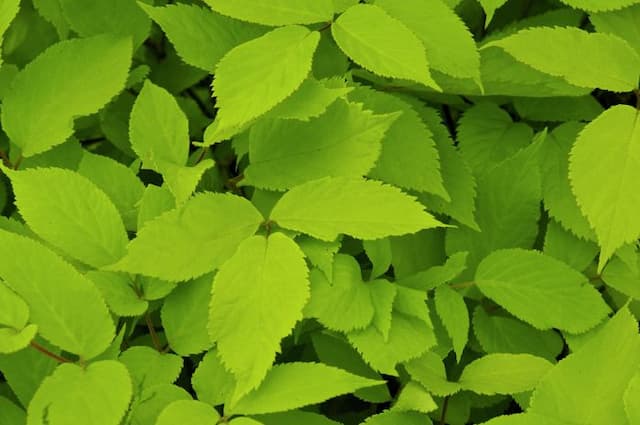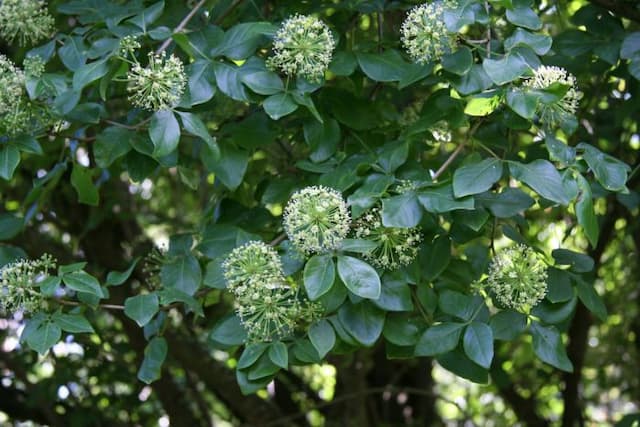Irish Ivy Hedera hibernica 'Angularis Aurea'

ABOUT
The plant known as the Irish ivy 'Angularis Aurea' is a striking evergreen vine characterized by its decorative foliage. This plant boasts heart-shaped leaves that have a unique appearance. Each leaf typically features a golden-yellow hue at the margins, fading to a rich, deep green toward the center. This variegation creates a vibrant contrast that can bring a splash of color to any garden space. The leaves of Irish ivy 'Angularis Aurea' are glossy, adding a reflective quality that can brighten shady areas. The distinctive leaf shape shows pointed lobes which is a signature trait for this variety. The plant has a vigorous climbing habit, often seen trailing or spreading over surfaces with the help of its aerial roots that easily cling to supports. This type of ivy is commonly used to provide a dense cover on walls, fences, or trellises, giving a lush and full appearance. In addition to its ornamental leaves, Irish ivy 'Angularis Aurea' can also produce small, inconspicuous flowers followed by dark berries which are more prominent in the wild and may not be as noticeable in a typical garden setting. The overall impression of this plant is a cascade of gold-edged greenery that can add interest and texture to both vertical and horizontal spaces in the landscape.
About this plant
 Names
NamesFamily
Araliaceae.
Synonyms
Atlantic Ivy, Irish Ivy.
Common names
Hedera helix 'Angularis Aurea', Hedera helix var. chrysocarpa, Hedera helix f. chrysocarpa.
 Toxicity
ToxicityTo humans
The plant commonly known as Irish Ivy is considered to be toxic to humans if ingested. The primary toxic components of Irish Ivy are saponins and polyacetylene compounds. Symptoms of intoxication may include gastrointestinal discomfort, such as diarrhea, vomiting, and abdominal pain. In some cases, individuals may experience contact dermatitis when handling the plant, due to skin sensitivity to certain compounds in the sap. Ingesting large amounts of the plant can possibly lead to more severe reactions and should be avoided.
To pets
Irish Ivy poses a risk of toxicity to pets if consumed. The plant contains saponins and polyacetylene compounds, which can be harmful. Symptoms of poisoning in pets may include vomiting, diarrhea, drooling, and abdominal pain. In severe cases, ingestion can potentially cause tremors, muscle weakness, and coordination problems. Pets should be prevented from eating any part of the plant to avoid these possible consequences.
 Characteristics
CharacteristicsLife cycle
Perennials
Foliage type
Evergreen
Color of leaves
Variegated
Height
6-9 feet (1.8-2.7 meters)
Spread
3-50 feet (1-15 meters)
Plant type
Climber
Hardiness zones
5
Native area
Europe
Benefits
 General Benefits
General Benefits- Aesthetic Appeal: The variegated leaves of the plant add color and visual interest to gardens or indoor spaces.
- Versatility: It can be used in a variety of landscaping designs, including ground cover, climbing walls, or trailing from containers.
- Low Maintenance: Requires minimal care once established, making it an ideal choice for busy gardeners.
- Durability: Tolerant to a range of conditions, including poor soils, shade, and urban pollution.
- Wildlife Support: Provides shelter and sometimes food for birds and insects.
- Rapid Growth: Quickly covers unsightly areas, making it useful for hiding fences or unattractive structures.
- Soil Erosion Control: Its root system helps to stabilize soil on slopes, reducing erosion.
- Seasonal Interest: Evergreen nature ensures year-round greenery in the garden.
- Privacy: When used as a climber, it can create a dense screen that enhances privacy.
 Medical Properties
Medical PropertiesThis plant is not used for medical purposes.
 Air-purifying Qualities
Air-purifying QualitiesThis plant is not specifically known for air purifying qualities.
 Other Uses
Other Uses- Hedera hibernica, commonly known as Atlantic Ivy, can be used for topiary in gardens due to its ability to be shaped and trained along frames or structures.
- It serves as a natural sound barrier when grown densely along walls or fences, helping to reduce noise pollution.
- The dense foliage of Atlantic Ivy can be utilized for creating green roofs, offering insulation and contributing to urban greening.
- Atlantic Ivy can be used in landscape design to create 'green curtains' on building exteriors, which has the added benefit of shading and cooling structures.
- The vigorous growth of Atlantic Ivy can help prevent soil erosion on slopes or in areas prone to erosion thanks to its rooting system.
- It provides a natural habitat for native wildlife, including birds and beneficial insects, when grown as a ground cover or on structures.
- As a living fence, Atlantic Ivy can offer privacy and delineate spaces within a garden setting without the need for built structures.
- In theatrical productions or films, Atlantic Ivy can be used to create a moody or aged setting, quickly transforming sets with an overgrown look.
- Atlantic Ivy can also be used in floral arrangements or as decoration in festive wreaths, bringing a touch of nature indoors.
- When used in educational projects, it can be an excellent plant for studying climbing mechanisms or plant adaptation in botany classes.
Interesting Facts
 Feng Shui
Feng ShuiThe plant known as Irish Ivy is not used in Feng Shui practice.
 Zodiac Sign Compitability
Zodiac Sign CompitabilityIrish Ivy is not used in astrology practice.
 Plant Symbolism
Plant Symbolism- Connection: Known as Irish Ivy, Hedera hibernica 'Angularis Aurea' often symbolizes connection and friendship due to its climbing and evergreen nature, representing the idea of sticking by and supporting someone.
- Eternal Life: As an evergreen plant, Irish Ivy is also a symbol of eternity and immortality, reflecting the perpetual cycle of life.
- Protection: Ivy is traditionally believed to ward off evil spirits, and having Irish Ivy around one's home is thought to offer protection against negative energy.
- Fidelity: The plant's ability to cling tightly to surfaces embodies faithfulness and strong relationships, making it a symbol of wedded love and friendship.
- Survival: Irish Ivy's hardiness and ability to thrive in challenging conditions make it a symbol of survival and overcoming adversity.
 Water
WaterThe Irish Ivy 'Angularis Aurea' should be watered thoroughly when the top inch of soil feels dry to the touch. Depending on the environment, this could be approximately once a week, but always check soil moisture before watering. Provide enough water to soak the soil all the way to the roots; for a potted plant, this might take around a gallon of water, ensuring it drains well and there's no standing water. During winter months, reduce watering frequency as the plant's growth slows down and less water is required.
 Light
LightIrish Ivy 'Angularis Aurea' thrives in a variety of light conditions, from bright, indirect light to low light situations. However, to maintain its variegated leaves, a spot with bright, indirect light is ideal. Avoid direct sunlight, especially during the hottest parts of the day, which can scorch the leaves.
 Temperature
TemperatureThe Irish Ivy 'Angularis Aurea' prefers temperatures between 50 and 70 degrees Fahrenheit for optimal growth. It can survive minimum temperatures down to around 30 degrees Fahrenheit and maximum temperatures up to about 90 degrees Fahrenheit, but fluctuations outside of this range may stress the plant.
 Pruning
PruningPruning the Irish Ivy 'Angularis Aurea' helps maintain its shape, control its size, and encourage denser foliage. Prune as needed throughout the year, but the best time for major pruning is in early spring before new growth starts. You can remove any dead or damaged leaves and trim back to your desired shape or size.
 Cleaning
CleaningAs needed
 Soil
SoilIrish Ivy thrives best in a soil mix consisting of equal parts peat, pine bark, and perlite or coarse sand to ensure good drainage. It prefers a slightly acidic to neutral pH, ranging from 6.0 to 7.5, to maximize nutrient uptake and support healthy growth.
 Repotting
RepottingThe Irish Ivy should be repotted every two to three years to refresh the soil and provide room for growth. However, being a vigorous climber, check yearly for root crowding and repot as necessary.
 Humidity & Misting
Humidity & MistingIrish Ivy prefers moderate to high humidity levels, ideally around 40-50%, to maintain glossy leaves and vigorous growth. Avoid excessively dry air environments, which can lead to leaf desiccation and pest infestations.
 Suitable locations
Suitable locationsIndoor
Place near window, moderate light, avoid direct sun.
Outdoor
Choose shaded area, well-draining soil, protect from hot sun.
Hardiness zone
5-11 USDA
 Life cycle
Life cycleThe Irish Ivy 'Angularis Aurea' begins its life as a seed, which germinates when the conditions of moisture, temperature, and light become favorable. The seedling emerges and develops into a juvenile plant, characterized by rapid growth and its distinct lobed leaves. As it matures, the plant enters the adult vegetative stage, with the development of unlobed, adult leaves; the plant is now ready to climb and spread with the help of its aerial rootlets. It may take several years for the plant to reach maturity and produce flowers. Once flowering occurs, typically in the fall, it produces small, inconspicuous yellow-green flowers that are highly attractive to bees and followed by blackberry-like fruits if pollinated. These fruits are then consumed by birds, which help disperse the seeds to close the life cycle.
 Propogation
PropogationPropogation time
Spring-Early Summer
Propogation: The Atlantic Ivy 'Angularis Aurea' is best propagated through stem cuttings, a technique typically carried out in spring or early summer to take advantage of the growing season. To propagate by this method, select a healthy, non-flowering stem and cut a segment about 4 to 6 inches (approximately 10 to 15 centimeters) long, making sure it has at least two sets of leaves. Remove the lower leaves and dip the cut end in a rooting hormone powder to enhance root development. Plant the cutting in a pot with well-draining potting soil, ensuring the node (where the leaves were removed) is buried. Keep the soil consistently moist but not waterlogged, and place the pot in a warm area with indirect light. Roots typically form within several weeks, after which the new Atlantic Ivy plant can eventually be transplanted outdoors or into a larger container.









